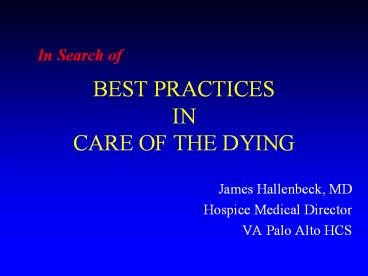BEST PRACTICES IN CARE OF THE DYING - PowerPoint PPT Presentation
Title: BEST PRACTICES IN CARE OF THE DYING
1
BEST PRACTICESINCARE OF THE DYING
In Search of
- James Hallenbeck, MD
- Hospice Medical Director
- VA Palo Alto HCS
2
OverviewBest Practices
A conceptual framework
- Various groups working on guidelines
- AMA
- ABIM
- National Cancer Care Network
- Position papers/policies
- Last Acts Precepts of Palliative Care
- VA policy on Pain as the Fifth Vital Sign
Among others
3
Domains of EOL Care
Pain Management Non-pain Symptom
Management Communication Ethics Psychosocial,
Spiritual Care System issues
4
Pain ManagementStandards of Care
- Patient Centered
- Standardized assessment tools
- Pain as the Fifth Vital Sign
- Monitoring is incorporated into quality
management - Specific prescribing guidelines
- Ex. For chronic pain, rely on long-acting oral
opioids with short-acting breakthrough doses
5
Pain Management Controversies
- Generalist vs. specialist
- Palliative Care specialist vs. Pain Management
specialist - In Geriatrics- traditional vs. palliative
approach - Polypharmacy vs. mult-modality therapy
- Emphasis on functional status vs. relief of
suffering
6
Non-pain Symptom Management
What symptoms are we talking about?
- Constipation
- Dyspnea
- Nausea and vomiting
- Dry mouth
- Plus approximately 50 more...
7
Non-pain Symptom ManagementStandards of Care
- Overall- emphasis on tailoring drug therapy to
specific cause(s) of symptoms - Constipation
- start treatment when starting opioids
- more patient/nurse autonomy in treatment
- Dyspnea
- central role of opioids, benzodiazepines
- Nausea and vomiting
- dopamine antagonists for opioid related nausea
8
Non-pain Symptom ManagementControversies
- Role of antibiotics in certain infections
- Role of artificial hydration/nutrition
- Use of newer, often more expensive palliative
medicines - Ex. 5HT3 antagonists for nausea
- Overlap/differences between traditional and
palliative care for certain symptoms
9
CommunicationStandards of Care
- Active Listening
- Assessment of patient preferences
- Current as well as advance directives
- Sharing of bad news
- How to pronounce a patient
- Patient/family education
- Prognosis, care options, goals of therapy, normal
changes of dying
10
CommunicationControversies
- Who should communicate what?
- Time and money involved in good communication
- Cultural factors
- Attending physician role in modeling/teaching
communication skills - Much EOL communication part of resident
sub-culture
11
EthicsControversies
- Physician Assisted Suicide (PAS)
- Voluntary Euthanasia (VE)
- Terminal Sedation (TS)
- Voluntary Self-discontinuation of Eating and
Drinking (VSED) - Futility
- Who pays for what? (Issues of justice)
- Cultural factors
12
EthicsStandards of Care
- Discussion and documentation of current and
advance directives - Non-abandonment
- Respect for patient, family, healthcare worker
values - Importance of cultural competency
- Availability of ethics consultation
13
Psychosocial, Spiritual CareStandards of Care
- Recognition/treatment of depression
- Recognition of the family as the unit of care
- Appreciation for economics of EOL care
- Importance of addressing patient/family spiritual
needs - Bereavement support
14
Psychosocial, Spiritual CareControversies
- Treatment of terminal delirium
- Role of the physician in this area, esp.
addressing spiritual suffering - Are we at risk of forcing our notion of a good
death onto others? - Reimbursement for this care
- In Geriatrics- Independence vs. Interdependence
15
System IssuesStandards of Care
- Universal access to appropriate EOL care
- Coordination of care across venues
- Treatment of patients in the venue of care
desired to the extent possible - Interdisciplinary approach to care
- Incorporation of monitors into quality management
structure and accreditation
16
System IssuesControversies
- ? Right to EOL care
- Hospice vs. Palliative care
- Role of managed care
- Proper reimbursement structure (taking into
account) - different dying trajectories (problems with
prognosis) - different patient/family preferences for care
- differences in case-mix
17
Summary
- Standards of care are beginning to evolve
- Large gaps between best practices and current
level of practice - Major controversies exist as to what constitute
best practices































